
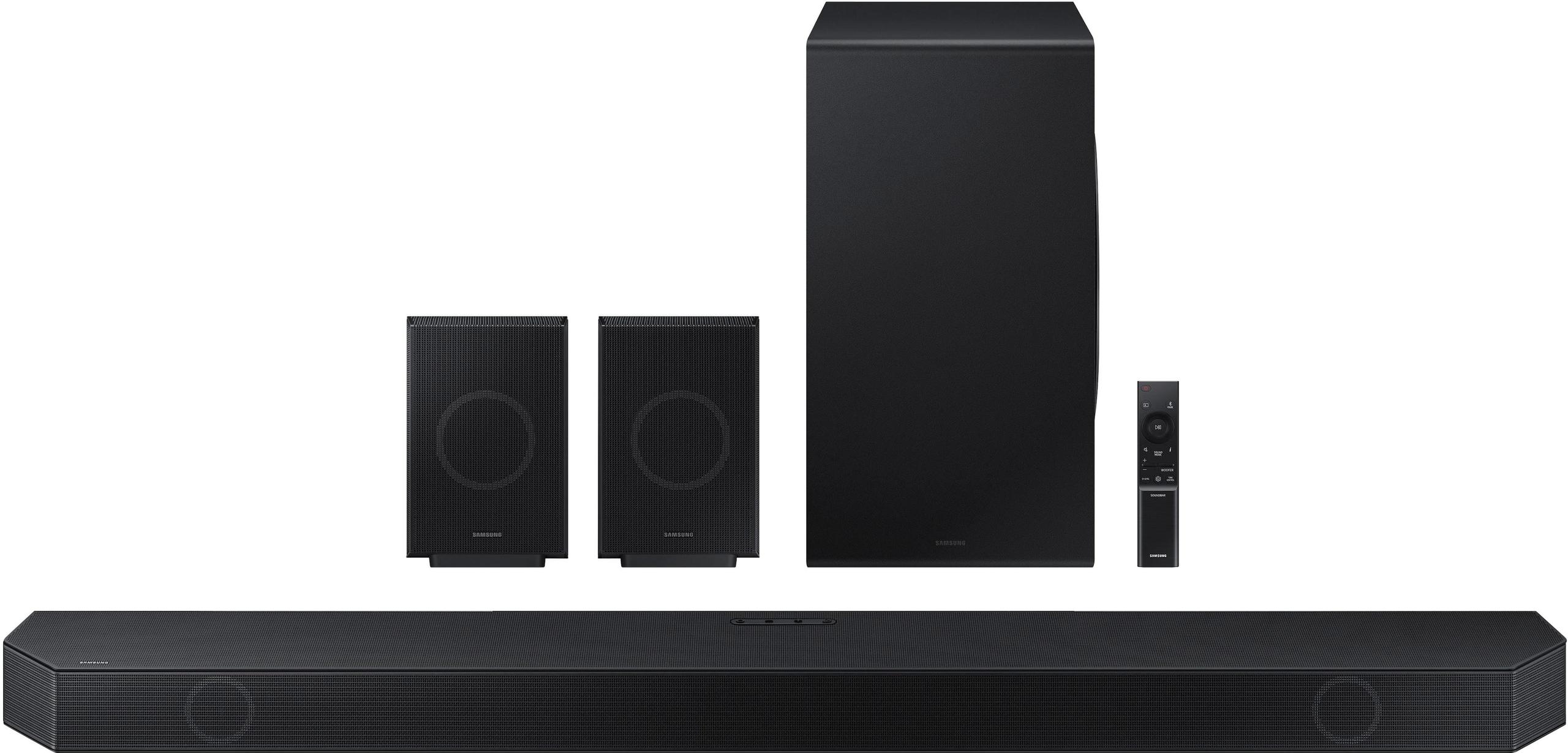
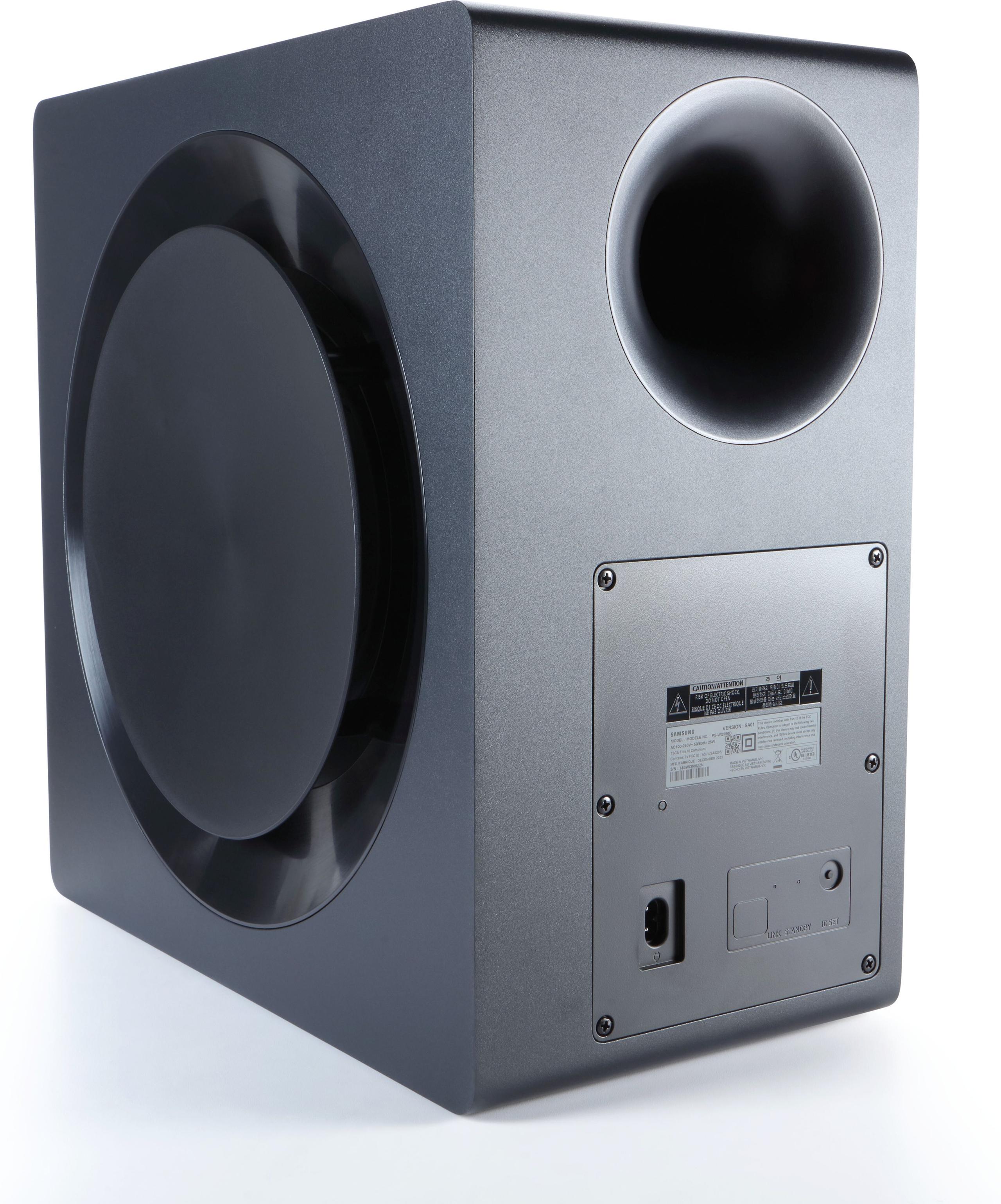
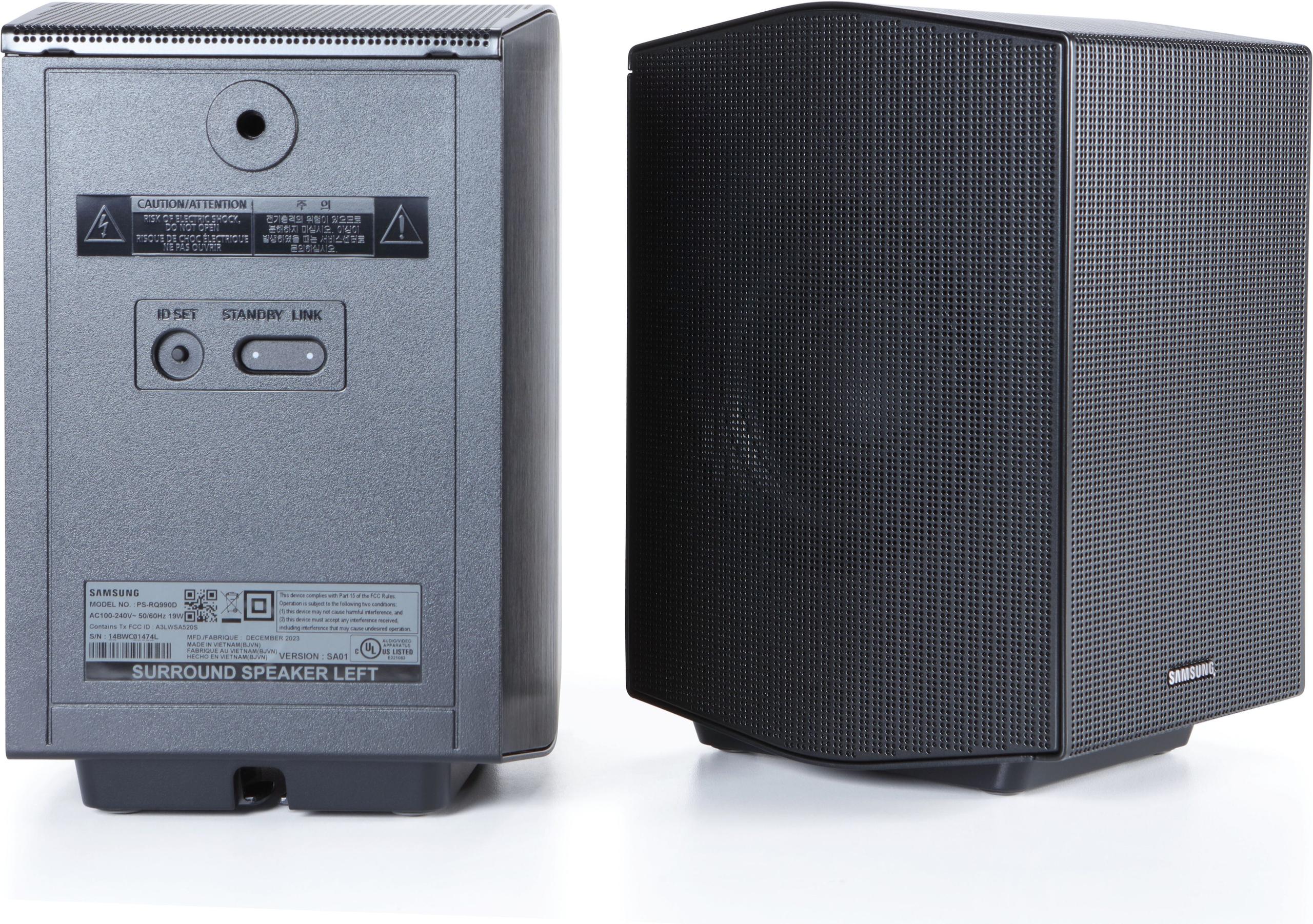
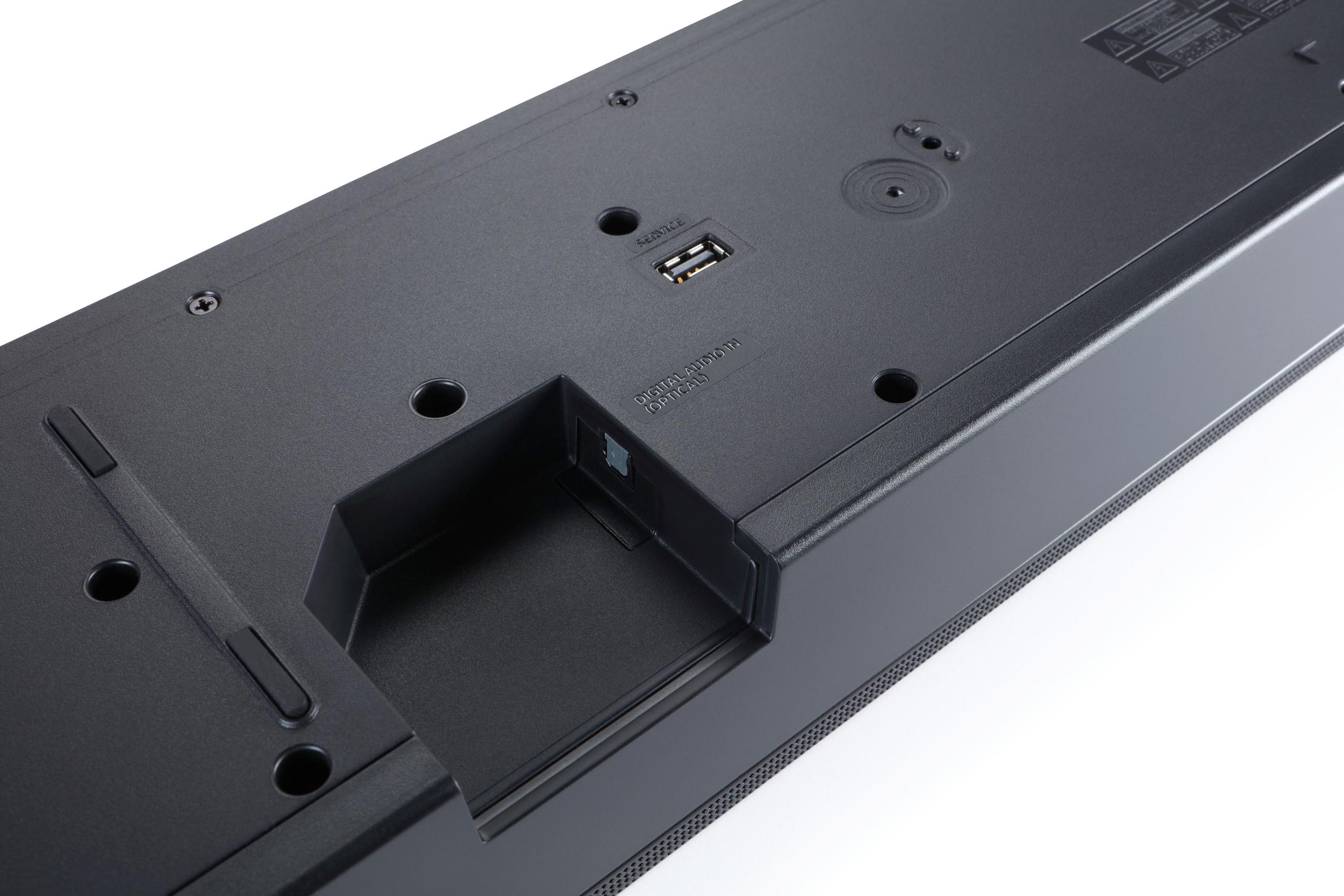
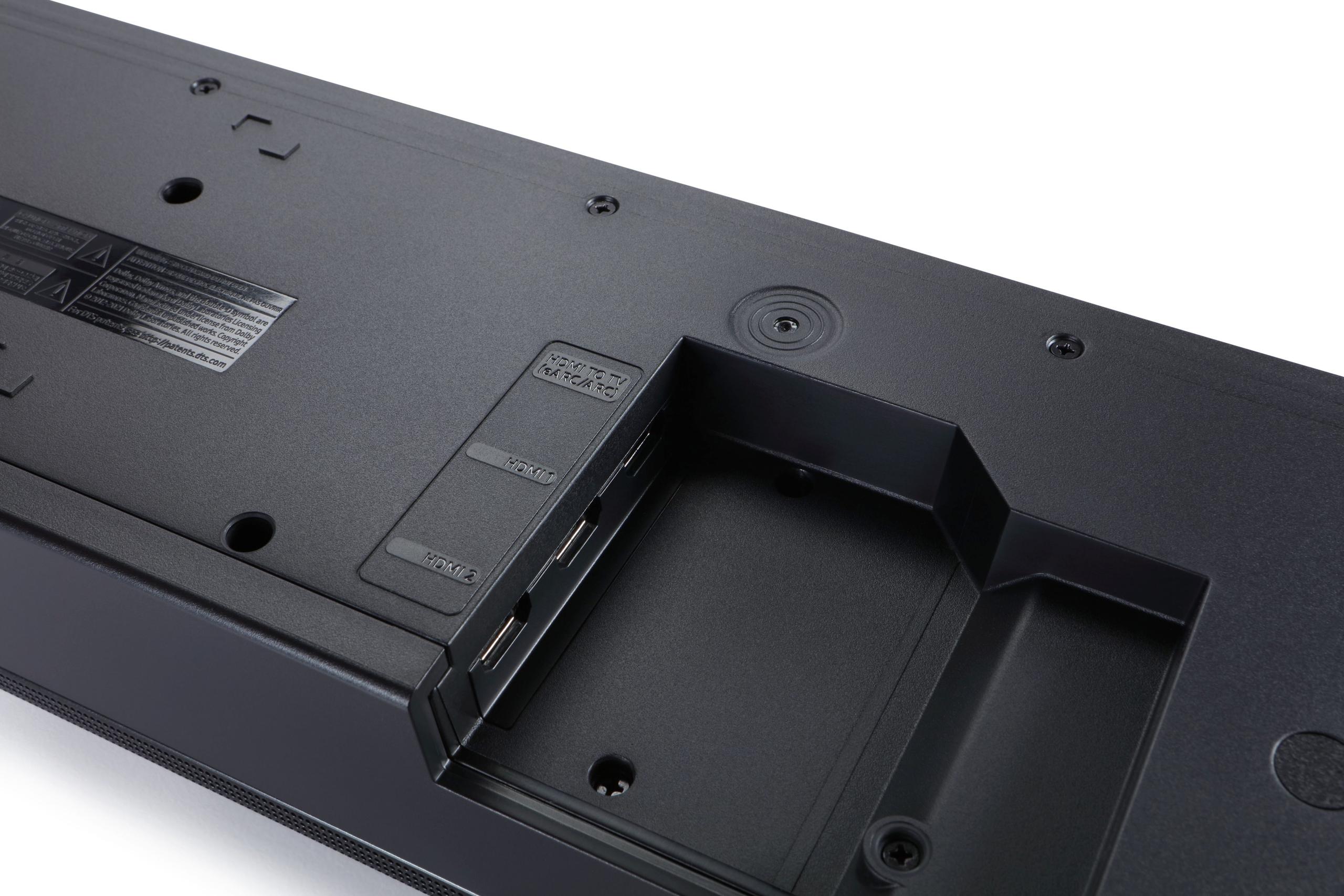

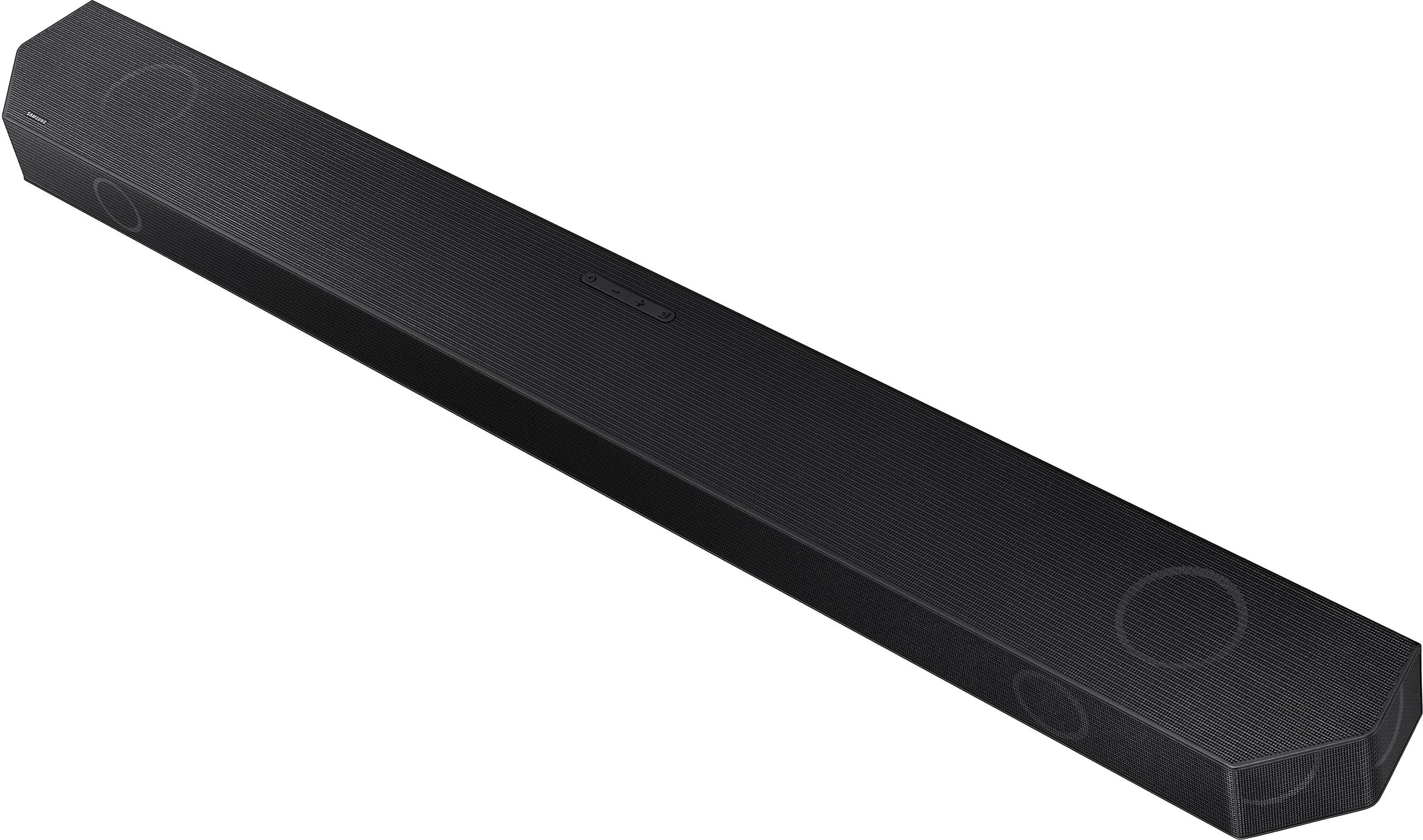
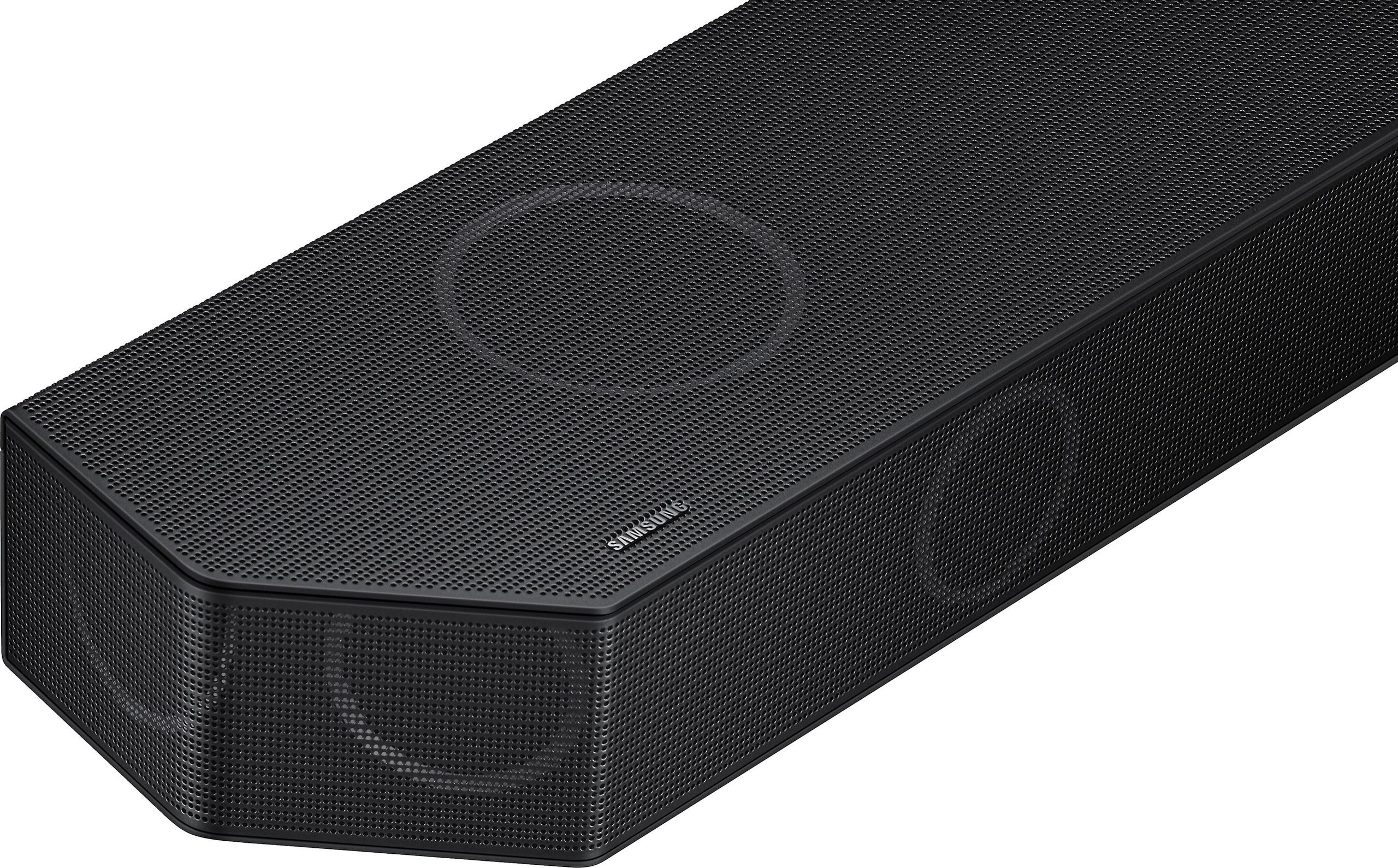


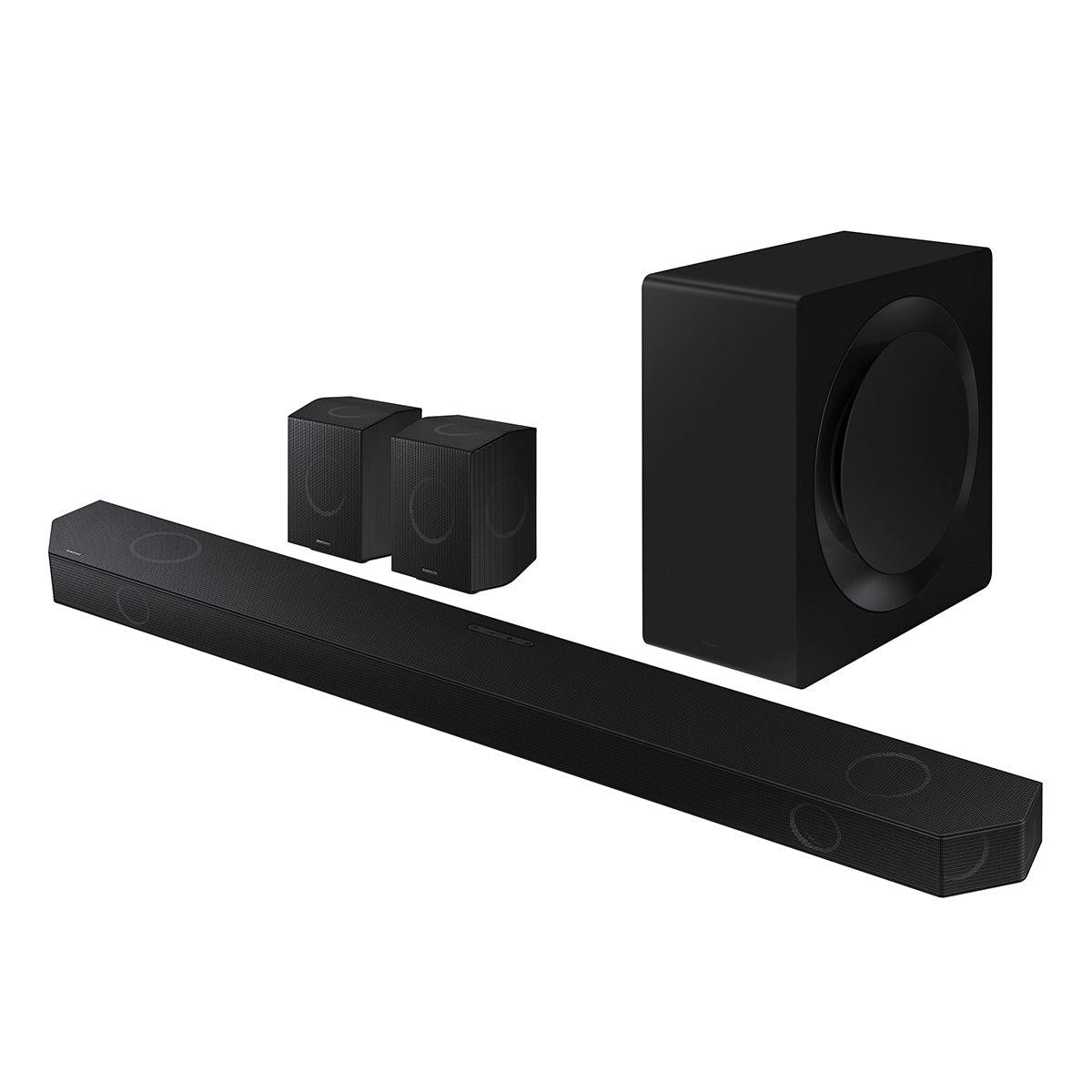












$874.29
When Samsung released the HW-Q990D ($1,999) in mid-2023, it represented their most ambitious soundbar yet. Having spent extensive time testing it in various room configurations, I can confidently say this system delivers on its premium promises - though with some interesting caveats worth discussing.
The soundbar market has changed dramatically over the last few years. Where basic 2.1 systems once dominated, we're now seeing sophisticated setups that rival traditional home theater installations. The Q990D exemplifies this evolution, building upon last year's Q990C with refined audio processing and enhanced gaming features.
The 11.1.4 setup might seem like just numbers, but here's what it actually means: you get 11 main channels for surround sound, 1 subwoofer channel for bass, and 4 upward-firing speakers for height effects. In practice, this creates a dome of sound around your listening position.
During our testing, this translated to remarkable experiences with movies like "Dune," where sand storms genuinely seemed to swirl overhead, while dialogue remained crystal clear from the center channel.
SpaceFit Sound Pro, Samsung's room correction technology, continuously analyzes your space using built-in microphones. Unlike traditional one-time calibration systems, it adjusts in real-time to maintain optimal sound. We found this particularly effective when testing in different room sizes - from small bedrooms to large open-plan spaces.
The inclusion of HDMI 2.1 ports isn't just a spec sheet bullet point - it enables crucial features for next-gen gaming:
Testing with a PS5 and Xbox Series X, the Game Mode Pro feature noticeably enhanced positional audio in titles like Call of Duty and Horizon Forbidden West.
The Q990D offers comprehensive connectivity:
This flexibility proved invaluable in daily use, seamlessly switching between movie nights, casual music listening, and gaming sessions.
In our dedicated testing room, the Dolby Atmos performance was particularly impressive with films like "Top Gun: Maverick." The jet flyovers utilized all 22 speakers to create convincing overhead passes, while the subwoofer delivered impactful explosions without overwhelming dialogue.
While soundbars aren't typically associated with high-end music reproduction, the Q990D surprises here. Testing across genres revealed:
The dedicated Game Mode Pro isn't just marketing - it genuinely enhances spatial awareness in games. During testing with Returnal on PS5, the precise positioning of enemies and environmental effects added a new dimension to gameplay.
The system requires some space to perform optimally:
We found the wireless rear speakers particularly flexible in placement, though they perform best at ear level.
At $1,999, the HW-Q990D represents a significant investment. However, when compared to traditional home theater setups offering similar capabilities, the value proposition becomes clearer:
After extensive testing across various content types and room configurations, the Samsung HW-Q990D emerges as a compelling option in the premium soundbar category. While the price point requires careful consideration, the combination of cutting-edge features, exceptional performance, and practical convenience makes it a standout choice for 2023.
The system particularly shines in mixed-use scenarios where a traditional home theater setup might be impractical. The ability to seamlessly switch between immersive movie watching, high-quality music playback, and next-gen gaming makes it a versatile hub for modern entertainment.
For those with the budget and space, the Q990D represents the current peak of soundbar technology, offering a compelling alternative to more complex home theater solutions while delivering performance that will satisfy all but the most demanding audiophiles.
The Samsung HW-Q990D ($1,999) is worth the investment if you want premium home theater sound without the complexity of a traditional speaker setup. Its 11.1.4 channel configuration, Dolby Atmos support, and advanced gaming features make it an excellent choice for both movies and gaming.
The HW-Q990D features 22 total speakers across the main soundbar, wireless subwoofer, and two rear speakers, creating a complete 11.1.4 channel surround sound system.
Yes, the soundbar works with any TV that has HDMI or optical connections. However, you'll get additional features like Q-Symphony when paired with a compatible Samsung TV.
The HW-Q990D excels at movie playback with its Dolby Atmos and DTS:X support, powerful subwoofer, and precise surround sound capabilities, making it ideal for home theater use.
Yes, the soundbar can be wall-mounted, and mounting brackets are included in the box. The rear speakers can also be wall-mounted, while the subwoofer remains floor-standing.
The HW-Q990D performs best in medium to large rooms (200-400 square feet), though its SpaceFit Sound Pro technology helps optimize performance for any room size.
Yes, it fully supports next-gen gaming with HDMI 2.1 features including 4K/120Hz pass-through, VRR, and ALLM, making it perfect for modern gaming setups.
Yes, the soundbar supports multiple streaming options including Bluetooth, WiFi, AirPlay 2, and Chromecast, making it versatile for music playback.
No, the HW-Q990D is designed for easy DIY setup with wireless rear speakers and subwoofer. The automatic room calibration handles sound optimization.
While dedicated home theater systems can offer more customization, the HW-Q990D provides comparable performance with much easier setup and less complexity, making it an excellent choice for most users wanting premium surround sound.
We've done our best to create useful and informative comparisons to help you decide what product to buy. Our research has used advanced automated methods to create this comparison and perfection is not possible - please contact us for corrections or questions. These are the sites we've researched in the creation of this article: techradar.com - avsforum.com - valueelectronics.com - samsung.com - rtings.com - samsung.com - avsforum.com - samsung.com - cdwg.com - youtube.com - whathifi.com
| Samsung HW-Q990D $1,999 |
|---|
| Audio Channels - Determines surround sound capability: 11.1.4 channels with 22 total drivers |
| Dolby Atmos & DTS:X Support - Enables true 3D audio positioning: Yes, with dedicated height channels |
| HDMI Ports - Critical for modern gaming and AV systems: 2 HDMI 2.1 inputs, 1 eARC output |
| Gaming Features - Essential for next-gen console compatibility: 4K/120Hz, VRR, ALLM |
| Room Calibration - Optimizes sound for your space: SpaceFit Sound Pro with continuous adjustment |
| Wireless Audio Formats - For streaming flexibility: WiFi, Bluetooth 5.2, AirPlay 2, Chromecast |
| Voice Assistant Support: Alexa, Google Assistant, Bixby |
| Soundbar Dimensions: 51.3 x 23.4 x 10.9 inches |
| Subwoofer Size: 8.6 x 16.2 x 16.1 inches |
| Rear Speaker Size: 5.0 x 7.9 x 5.5 inches |
| Special Features - Enhances functionality: Q-Symphony (Samsung TV integration), Private Rear Sound mode |
| HDR Pass-through - Important for video quality: HDR10+, Dolby Vision |
The Samsung HW-B550D ($178) offers an impressive value proposition for those seeking basic audio enhancement without the premium features of the Q990D. Its 3.1 channel configuration, while much simpler, still delivers clear dialogue through its dedicated center channel and provides satisfying bass via its wireless subwoofer. For basic TV viewing and casual music listening in smaller spaces, the B550D handles the fundamentals well, supporting common audio formats like Dolby Digital and offering straightforward Bluetooth connectivity for music streaming.
Where the B550D really shines is in its price-to-performance ratio for everyday use. At about one-tenth the cost of the Q990D, it provides a significant upgrade over built-in TV speakers without the complexity of a full surround system. While it can't match the Q990D's immersive experience or advanced features, its simpler setup and smaller footprint make it an excellent choice for apartments, bedrooms, or anywhere a basic audio upgrade is needed. For many users, especially those with smaller rooms or primarily watching standard TV content, the B550D's performance hits a sweet spot that makes the Q990D's premium features unnecessary.
🤖 Read Detailed Comparison
👌Samsung HW-B550D 3.1 Channel Sound Bar Details
💵 See Samsung HW-B550D 3.1 Channel Sound Bar Price
The Bose Solo Soundbar Series 2 at $179 takes a fundamentally different approach, offering a simple, single-unit solution for those seeking basic TV audio improvement. While it can't match the Samsung's immersive surround capabilities, it excels at its primary mission: delivering clearer dialogue and better overall sound than built-in TV speakers. Its compact design and straightforward setup make it particularly appealing for smaller spaces or situations where a full surround system would be impractical.
Where the Bose Solo Series 2 really shines is in its value proposition for basic TV viewing. It handles stereo content competently and includes Bluetooth streaming capability, all while maintaining Bose's reputation for clear sound reproduction. While it lacks the Samsung's advanced features like Dolby Atmos, gaming support, and deep bass response, it serves as an excellent entry-level option for those who want better TV sound without the complexity and cost of a premium system. The Bose might be the smarter choice for apartments, bedrooms, or any situation where simplicity and budget are primary concerns.
🤖 Read Detailed Comparison
👌Bose Solo Soundbar Series 2 Soundbar Details
💵 See Bose Solo Soundbar Series 2 Soundbar Price
The $349 Klipsch Flexus Core 100 offers an interesting alternative for those seeking quality sound without the complexity and cost of a full surround system. Its cleverly designed 2.1 channel configuration includes dual built-in subwoofers, eliminating the need for a separate bass unit while still delivering impressive low-end response. The soundbar's expandability is particularly noteworthy, allowing users to add wireless rear speakers and a subwoofer later, essentially creating a modular upgrade path that can grow with your needs and budget. For smaller rooms and apartments, the all-in-one design might actually be preferable, offering a clean aesthetic and neighbor-friendly bass management.
While the Klipsch Flexus Core 100 can't match the immersive experience of the Q990D's dedicated surround and height channels, it excels at its core mission of delivering clear, detailed sound with strong stereo separation. The simpler setup and lower price point make it an excellent choice for those primarily watching TV shows and streaming content, or for situations where a full surround setup isn't practical. The limited connectivity options and lack of advanced features like room correction or gaming-specific support reflect its focus on fundamental sound quality over bells and whistles. For many users, especially those in spaces under 200 square feet, the performance-to-price ratio might actually make more sense than investing in a premium surround sound system.
🤖 Read Detailed Comparison
👌Klipsch Flexus Core 100 Soundbar Details
💵 See Klipsch Flexus Core 100 Soundbar Price
For those considering a more budget-friendly option, the Samsung HW-S700D ($398) offers impressive performance in a slim, space-conscious design. While it can't match the Q990D's immersive surround capabilities, its 3.1 channel configuration excels at dialogue clarity and delivers surprisingly robust bass from its compact subwoofer. The slim profile makes it particularly appealing for wall-mounted setups or smaller rooms where a full surround system would be impractical.
At one-fifth the price of the Q990D, the HW-S700D represents excellent value for everyday TV viewing and casual movie watching. It shares several premium features with its higher-end sibling, including Q-Symphony compatibility with Samsung TVs, SpaceFit Sound calibration, and wireless streaming capabilities. While it lacks true Dolby Atmos and rear speakers, its virtual surround processing creates a convincingly wide soundstage that will satisfy most users who prioritize simplicity and space efficiency over complete home theater immersion.
🤖 Read Detailed Comparison
👌Samsung HW-S700D 3.1 Channel Slim Soundbar Details
💵 See Samsung HW-S700D 3.1 Channel Slim Soundbar Price
The Sony HT-A8000 ($698.00) offers an impressive alternative at a significantly lower price point, delivering robust Dolby Atmos performance through its 7.1.2 channel configuration. While it doesn't match the Q990D's full surround capability, its 360 Spatial Sound Mapping technology creates convincing virtual surround effects that work particularly well in small to medium-sized rooms. The single-bar design makes it an excellent choice for those who want simplified setup and clean aesthetics, and its integration with Sony TVs through Acoustic Center Sync offers unique benefits for Sony TV owners.
Where the HT-A8000 really shines is in its value proposition and flexibility. At just over one-third the price of the Samsung, it delivers roughly 80% of the audio performance for most content. While it lacks advanced gaming features and the immersion of physical rear speakers, its expandability with optional wireless surrounds and subwoofer lets users enhance their system over time. For apartments, smaller living rooms, or anyone prioritizing simplicity and value over absolute performance, the Sony presents a compelling alternative that doesn't compromise significantly on sound quality for everyday viewing.
🤖 Read Detailed Comparison
👌Sony HT-A8000 BRAVIA Theater Bar 8 Soundbar Details
💵 See Sony HT-A8000 BRAVIA Theater Bar 8 Soundbar Price
For those considering a more budget-friendly option, the Samsung HW-Q800D ($699) offers impressive performance at just one-third the price of the Q990D. While it drops down to a 5.1.2 channel configuration, it still delivers excellent Dolby Atmos performance through its two upfiring speakers and provides robust bass via its included wireless subwoofer. The Q800D shares many of the premium features found in its bigger sibling, including SpaceFit Sound Pro room correction, Q-Symphony integration with Samsung TVs, and voice assistant compatibility.
Where the Q800D really shines is in its value proposition for smaller to medium-sized rooms. Without rear speakers, it's also a more practical solution for spaces where speaker placement might be challenging. While it can't match the Q990D's immersive surround sound capabilities or gaming-focused HDMI 2.1 features, the HW-Q800D delivers about 80% of the flagship's performance for most common uses like movies, TV shows, and music. For many users, especially those without dedicated home theater rooms, the significant cost savings might be better spent on other aspects of their entertainment setup.
🤖 Read Detailed Comparison
👌Samsung HW-Q800D 5.1.2 Channel Soundbar Details
💵 See Samsung HW-Q800D 5.1.2 Channel Soundbar Price
The Sonos Arc Ultra takes a distinctly different approach to premium home audio, focusing on maximizing performance from a single unit rather than deploying multiple speakers. Its newly designed Sound Motion drivers and 14-speaker array create impressive sound coverage that belies its streamlined form factor. While it can't match the Q990D's true surround capabilities, it excels in delivering balanced, neutral sound that's particularly impressive with music playback. The Arc Ultra also offers superior ecosystem integration, regular software updates, and a cleaner aesthetic that many users prefer for mixed-use living spaces.
At $999, the Arc Ultra presents compelling value for those who prioritize simplicity and flexibility over maximum immersion. Its single-unit design eliminates complex speaker placement while still delivering convincing Dolby Atmos effects, and its superior musical performance makes it more versatile for everyday use. While the Sonos Arc Ultra may not reach the same cinematic heights as Samsung's full surround setup, its easier installation, expandability options, and more balanced sound signature make it an excellent choice for users who want premium audio without dedicating their space to multiple components.
🤖 Read Detailed Comparison
👌Sonos Arc Ultra Dolby Atmos Soundbar Details
💵 See Sonos Arc Ultra Dolby Atmos Soundbar Price
The LG S90TR ($799.99) stands out as a compelling alternative at less than half the price, offering a robust 7.1.3 channel configuration that delivers impressive performance for most home theater setups. While it may not match the Samsung's precise object placement and expansive soundstage, it provides excellent sound quality with clear dialogue, punchy bass, and convincing height effects that will satisfy most listeners. The system's AI Sound Calibration feature effectively optimizes audio for your specific room, and its WOW Orchestra technology creates seamless integration with LG TVs.
For those with medium-sized rooms or those prioritizing value, the LG S90TR offers an excellent balance of features and performance. While it lacks some of the gaming-focused features like full HDMI 2.1 support and has fewer audio channels overall, its real-world performance remains impressive for movies, music, and casual gaming. The wireless rear speakers and subwoofer provide true surround sound without cable clutter, and the system's more straightforward configuration might actually be preferable in rooms under 15x20 feet where additional channels might not provide significant benefits.
🤖 Read Detailed Comparison
👌LG S90TR 7.1.3 Channel Soundbar with Wireless Subwoofer and Rear Speakers - Soundbar Details
💵 See LG S90TR 7.1.3 Channel Soundbar with Wireless Subwoofer and Rear Speakers - Soundbar Price
For those seeking a more budget-friendly option, the Samsung B-Series 5.1 Channel Soundbar offers solid performance at $348, making it an attractive alternative for basic home theater needs. While it can't match the Q990D's immersive sound field, its 5.1 channel configuration with wireless subwoofer provides clear dialogue and decent bass response that significantly improves upon built-in TV speakers. The simpler setup process and straightforward features make it particularly appealing for users who want better sound without the complexity of advanced audio calibration or multiple HDMI connections.
However, the B-Series makes several compromises to achieve its lower price point. It lacks true Dolby Atmos support (offering only virtual processing), has limited connectivity options with just one HDMI input, and doesn't include features like room correction or advanced gaming modes. The sound stage is also notably smaller and less precise, though this may not be noticeable in typical living room settings with casual TV viewing. For many users, especially those with smaller rooms or primarily watching regular TV content, these limitations won't significantly impact their enjoyment, making the B-Series a sensible choice when premium features aren't a priority.
🤖 Read Detailed Comparison
👌Samsung B-Series 5.1 Channel Soundbar with Subwoofer Details
💵 See Samsung B-Series 5.1 Channel Soundbar with Subwoofer Price
The Sony BRAVIA Theater Bar 9 offers an intriguing alternative at $1,099, taking a minimalist approach with its single-bar design that houses 13 precisely tuned speakers. Its standout feature is the sophisticated 360 Spatial Sound Mapping technology, which creates virtual surround effects by bouncing sound off walls and ceilings. This approach works surprisingly well in small to medium-sized rooms, especially for those who want to avoid the complexity of placing multiple speakers. The Sony bar also excels at dialogue clarity through its Voice Zoom 3 technology, and its integration with Sony TVs is seamless through the BRAVIA Connect system.
However, the Sony's all-in-one approach does come with some compromises. Without a dedicated subwoofer, bass response is notably lighter, though this can be addressed by purchasing the optional wireless subwoofer. The virtual surround effect, while impressive for a single bar, can't quite match the precise sound placement of physical rear speakers. The bar's gaming performance is also more limited, with higher latency and no 4K/120Hz pass-through. That said, for those prioritizing simplicity and clean aesthetics, or those planning to build their system gradually, the Sony offers excellent value and surprisingly immersive sound from a single unit.
🤖 Read Detailed Comparison
👌Sony BRAVIA Theater Bar 9 Soundbar Details
💵 See Sony BRAVIA Theater Bar 9 Soundbar Price
The Yamaha SR-B40A ($399.95) offers an impressive value proposition with its straightforward 2.1-channel configuration, delivering clear dialogue and surprisingly powerful bass through its wireless subwoofer. While it can't match the Samsung's surround sound capabilities, it excels at what matters most: providing a significant upgrade over TV speakers with minimal complexity. The Yamaha's Clear Voice technology and well-tuned sound modes make it particularly effective for everyday TV watching, and its compact design works well in smaller spaces where multiple speakers might be impractical.
At just one-fifth the price of the Samsung, the Yamaha SR-B40A represents a smart choice for users who want better sound without the complexity and cost of a premium system. While it lacks advanced features like true Dolby Atmos, room correction, and gaming-specific enhancements, its performance-to-price ratio is excellent. The simpler two-piece setup might actually be preferable for many users, especially in apartments or smaller rooms where multiple speakers could be overwhelming. For those who prioritize value and simplicity over maximum immersion, the Yamaha offers most of the essential benefits of a soundbar at a much more accessible price point.
🤖 Read Detailed Comparison
👌Yamaha SR-B40A 2.1-Channel Sound Bar with Wireless Subwoofer Details
💵 See Yamaha SR-B40A 2.1-Channel Sound Bar with Wireless Subwoofer Price
The Bose Smart Ultra Soundbar ($899) takes a more streamlined approach, delivering impressive performance from a single unit at less than half the price. Its standout feature is the AI-powered dialogue enhancement, which consistently outperforms the Samsung's voice clarity processing. The Bose creates a surprisingly wide soundstage from its compact form factor, and its virtual surround processing is among the best available in a single-unit solution. For smaller rooms or simpler setups, its space-efficient design and straightforward installation make it an attractive alternative.
While the Bose Smart Ultra can't match the Samsung's true surround sound capabilities or bass response, it offers remarkable value for those who prioritize simplicity or have space constraints. Its advanced room calibration and smart assistant integration are more refined, and its single-unit design eliminates the complexity of positioning multiple speakers. Though it lacks the Samsung's gaming-focused features and immersive surround capabilities, the Bose delivers exceptional performance for its price point, making it a compelling choice for users who want to significantly upgrade their TV audio without committing to a full multi-speaker setup.
🤖 Read Detailed Comparison
👌Bose Smart Ultra Soundbar with Dolby Atmos Details
💵 See Bose Smart Ultra Soundbar with Dolby Atmos Price
The Bose TV Speaker ($279) takes a dramatically different approach, focusing on simplicity and essential TV audio enhancement rather than immersive home theater. Its compact, single-bar design prioritizes dialogue clarity and basic stereo performance, making it an excellent choice for viewers who want better sound than their TV speakers but don't need or want a complex audio system. The dedicated dialogue mode is particularly effective for news and TV shows, while the straightforward setup process - requiring just one cable connection - means anyone can have it up and running in minutes.
While it can't match the Samsung's surround sound capabilities or deep bass performance, the Bose delivers impressive audio quality for its size and price point. At less than a sixth of the Samsung's cost, it represents solid value for smaller rooms or situations where a full surround sound setup isn't practical or desired. The option to add a separate subwoofer later provides some flexibility for future upgrades, though it will never deliver the immersive experience of the Samsung's full speaker array. For many users, particularly those primarily watching regular TV programming or living in apartments, the Bose's simpler approach and lower price point might actually be the more practical choice.
🤖 Read Detailed Comparison
👌Bose TV Speaker Soundbar Details
💵 See Bose TV Speaker Soundbar Price
The LG S95TR distinguishes itself with its innovative triple up-firing speaker design and sleek aesthetic, offering a compelling alternative in the premium soundbar market. Its 9.1.5 channel configuration, while not as extensive as Samsung's, still delivers convincing Dolby Atmos performance, particularly in rooms with lower ceilings where the extra height channel can enhance overhead effects. The WOW Orchestra feature for LG TV owners provides similar ecosystem benefits to Samsung's Q-Symphony, and its more intuitive interface makes daily operation slightly more user-friendly.
However, at its typical street price of $1,531, the LG S95TR struggles to justify its cost compared to the Samsung's superior performance. While it handles basic home theater duties competently, it falls short in several key areas - notably room calibration accuracy, bass response, and overall sound placement precision. The less sophisticated AI Room Calibration and smaller subwoofer driver result in a less dynamic and impactful listening experience, particularly during complex action sequences or bass-heavy music. Unless you're firmly committed to the LG ecosystem or find it at a significant discount, the Samsung system offers better value and performance for most users.
🤖 Read Detailed Comparison
👌LG S95TR 9.1.5 Channel Soundbar with Dolby Atmos Soundbar Details
💵 See LG S95TR 9.1.5 Channel Soundbar with Dolby Atmos Soundbar Price
The Yamaha SR-B30A takes a dramatically different approach, offering a simple, single-unit solution at a much more accessible $299 price point. Its built-in subwoofers and compact design make it an attractive option for those who want better TV sound without the complexity of multiple speakers and wires. While it can't match the Q990D's immersive surround experience, its Clear Voice technology and virtual Dolby Atmos support provide noticeable improvements over basic TV speakers, especially for dialogue clarity in movies and TV shows.
For those seeking basic audio enhancement in smaller spaces or on a budget, the Yamaha SR-B30A delivers solid value with its straightforward setup and operation. It's particularly well-suited for apartments, bedrooms, or situations where a full surround sound system would be impractical. While it lacks advanced features like room calibration and gaming-specific modes, its simple HDMI eARC connection and Bluetooth streaming capability cover the essential needs of most users. The trade-off in performance versus the Q990D is significant, but so is the $1,700 price difference, making it a rational choice for those prioritizing simplicity and value over premium audio performance.
🤖 Read Detailed Comparison
👌Yamaha SR-B30A Sound Bar with Built-In Subwoofers Details
💵 See Yamaha SR-B30A Sound Bar with Built-In Subwoofers Price
The Sennheiser AMBEO Mini offers an intriguingly different approach to home theater sound, focusing on advanced virtual processing in a compact single-unit design. At just 27.6 inches wide and $799, it delivers impressive spatial audio through AMBEO virtualization technology, creating a convincing surround effect without the need for additional speakers. While it can't match the dynamic range and precise sound placement of physical surround speakers, its sophisticated processing creates an engaging soundstage that works particularly well in smaller spaces. The minimalist design and straightforward setup make it an attractive option for those who want to avoid the complexity of multiple speakers and wiring.
For apartments, bedrooms, or situations where space and aesthetics are primary concerns, the AMBEO Mini presents a compelling alternative to traditional surround sound systems. Its room calibration technology and adaptive sound processing help optimize performance for different spaces, though bass response is naturally limited without the optional wireless subwoofer. While it can't deliver the same level of immersion as the HW-Q990D's physical speaker array, the AMBEO Mini's performance-to-size ratio is impressive, and its lower price point makes it an attractive option for those seeking enhanced TV audio without committing to a full surround sound setup. The choice between these systems largely depends on room size, budget constraints, and whether simplicity is prioritized over maximum performance.
🤖 Read Detailed Comparison
👌Sennheiser AMBEO Soundbar Mini Details
💵 See Sennheiser AMBEO Soundbar Mini Price
The JBL Bar 1000 ($1,139.95) offers an innovative approach to surround sound with its battery-powered detachable rear speakers, providing unique flexibility for challenging room layouts. This 7.1.4 channel system delivers impressive performance through its MultiBeam technology and PureVoice dialogue enhancement, creating an immersive sound experience that rivals more expensive systems. The ability to place rear speakers without worrying about power outlets makes it particularly appealing for apartment dwellers or rooms with limited power access, and the 10-hour battery life ensures extended viewing sessions without interruption.
While the JBL system doesn't match the Samsung's channel count or advanced gaming features, it delivers approximately 80-90% of the audio performance at nearly $860 less. The JBL Bar 1000 excels in real-world usability with its straightforward setup process and efficient room calibration system. For most users who want premium Dolby Atmos performance without crossing the $1,500 threshold, the JBL provides exceptional value and versatility. Its primary compromises are the lack of HDMI 2.1 gaming features and slightly less precise sound positioning compared to higher-channel systems, but these differences may be negligible for all but the most demanding home theater enthusiasts.
🤖 Read Detailed Comparison
👌JBL Bar 1000 Surround Sound System with 7.1.4 Channel Soundbar, 10" Wireless Subwoofer, Detachable Rear Speakers, and Dolby Atmo Details
💵 See JBL Bar 1000 Surround Sound System with 7.1.4 Channel Soundbar, 10" Wireless Subwoofer, Detachable Rear Speakers, and Dolby Atmo Price
The $899 JBL Bar 700 offers an impressive value proposition with its 5.1 channel configuration and virtual Atmos effects. Its standout feature is the pair of detachable, battery-powered rear speakers, which provide true surround sound without permanent installation. The JBL's PureVoice technology delivers clear dialogue even during intense scenes, and its 10-inch wireless subwoofer provides solid bass performance for most content. While it can't match the Samsung's precise sound positioning, it creates an engaging and immersive soundstage that works particularly well in small to medium-sized rooms.
For those who don't need premium gaming features or Samsung TV integration, the JBL Bar 700 represents an excellent balance of performance and affordability. It offers many of the same streaming capabilities, including AirPlay and Chromecast built-in, and its simplified setup makes it more approachable for casual users. While it doesn't deliver the same level of overhead effects or channel separation as the HW-Q990D, the difference in real-world performance may not justify the additional $1,100 cost for many users, especially in typical living room environments where the full benefits of an 11.1.4 system might not be fully realized.
🤖 Read Detailed Comparison
👌JBL Bar 700 Dolby Atmos 5.1 Soundbar with Subwoofer Details
💵 See JBL Bar 700 Dolby Atmos 5.1 Soundbar with Subwoofer Price
The $498 Sony HT-A3000 offers an appealing alternative for those seeking premium sound without the complexity and cost of a full surround system. Its 3.1 channel configuration, while more basic, delivers surprisingly immersive audio through advanced virtual processing and built-in dual subwoofers. The soundbar excels at dialogue clarity and stereo music playback, making it particularly well-suited for everyday TV viewing and streaming content. Its compact design and straightforward setup process make it an excellent choice for smaller rooms or situations where running rear speaker wires isn't practical.
Where the Sony really shines is in its value proposition and versatility. While it can't match the Samsung's true surround sound capabilities or bass impact, it provides an impressive listening experience that significantly outperforms basic soundbars and TV speakers. The ability to add wireless rear speakers later offers a worthwhile upgrade path, and its robust streaming features, including high-resolution audio support, make it a capable all-in-one audio solution. For many users, especially those in apartments or smaller living rooms, the performance-to-price ratio may actually make more sense than investing in a full premium system.
🤖 Read Detailed Comparison
👌Sony HT-A3000 3.1ch Dolby Atmos Soundbar Details
💵 See Sony HT-A3000 3.1ch Dolby Atmos Soundbar Price
The Sonos Arc ($564) offers a compelling alternative with its elegant single-bar approach and significantly lower price point. Its strength lies in delivering impressive sound quality from a simplified setup, particularly excelling in music playback and dialogue clarity. The Arc's 11-driver array creates a surprisingly immersive soundstage for its size, and while it can't match the Q990D's true surround capabilities, its virtual Atmos implementation is remarkably effective in smaller to medium-sized rooms. The Sonos ecosystem also provides superior music streaming integration and a more refined user experience through its acclaimed app and voice assistant implementation.
Where the Sonos Arc really stands out is in its flexibility and upgrade path. Starting at just over a quarter of the Q990D's price, users can begin with the soundbar alone and add a wireless subwoofer and rear speakers later as budget allows. This scalability, combined with regular software updates and excellent multi-room audio capabilities, makes it an attractive option for those who want high-quality audio without committing to a full home theater setup immediately. However, potential buyers should consider that even when fully expanded with additional speakers, the Arc system won't deliver quite the same level of immersion or raw power as the Q990D's complete package.
🤖 Read Detailed Comparison
👌Sonos Arc Wireless Sound Bar with Dolby Atmos, Apple AirPlay 2, and Built-in Voice Assistant (White) Details
💵 See Sonos Arc Wireless Sound Bar with Dolby Atmos, Apple AirPlay 2, and Built-in Voice Assistant (White) Price
The JBL Bar 300 ($349.95) takes a remarkably different approach, focusing on delivering virtual surround sound from a single, compact unit. Its simplicity is a standout feature - there's no subwoofer to place, no rear speakers to mount, and setup takes minutes rather than hours. Through clever use of beamforming technology and six well-tuned drivers, it creates a surprisingly engaging soundstage that, while not matching the Samsung's true surround capabilities, offers a significant upgrade over built-in TV speakers. For smaller rooms and apartments, where space is at a premium or where running rear speaker wires isn't practical, this simplified approach has genuine merit.
At less than a fifth of the Samsung's price, the JBL Bar 300 represents an accessible entry point into better home theater audio. While it can't compete with the Samsung's powerful bass response or precise Atmos effects, it still supports Dolby Atmos processing and provides clear dialogue enhancement that makes a real difference for everyday TV watching. For many users, particularly those in smaller spaces or looking for a straightforward upgrade path, the JBL's balance of performance and value might actually be more practical than the Samsung's premium approach, even if the absolute audio quality doesn't reach the same heights.
🤖 Read Detailed Comparison
👌JBL Bar 300 5.0 Soundbar Details
💵 See JBL Bar 300 5.0 Soundbar Price
The Polk Audio MagniFi Max AX offers compelling value at $799, delivering impressive performance through its 3.1.2 channel configuration and surprisingly effective Dolby Atmos implementation. While it has fewer channels overall, its sound quality remains strong for medium-sized rooms, with particularly good dialogue clarity and music performance. The inclusion of three HDMI inputs actually exceeds the Samsung's connectivity options, and its support for popular streaming platforms like AirPlay 2 and Chromecast matches the core features most users need. The Polk's simpler setup process and more compact form factor also make it more practical for many living room installations.
Where the Polk naturally falls short is in creating the same level of immersion and precise sound placement that the Samsung achieves with its additional channels. Its two up-firing speakers, while effective, can't match the overhead effects produced by the Samsung's four height channels, and its basic room calibration lacks the sophisticated AI-powered optimization of the more expensive unit. However, these limitations need to be viewed in the context of its price point - at less than half the cost of the Samsung, the Polk delivers exceptional value for users who want quality Atmos performance without stretching their budget to premium pricing levels.
🤖 Read Detailed Comparison
👌Polk Audio MagniFi Max AX 3.1.2 Soundbar Details
💵 See Polk Audio MagniFi Max AX 3.1.2 Soundbar Price
The Sonos Ray ($279) takes a fundamentally different approach as an entry-level soundbar focused on simplicity and essential audio improvement. While it can't match the Q990D's immersive surround capabilities, it excels at dialogue clarity and basic stereo performance, making it an ideal solution for smaller rooms or viewers primarily watching news, sports, and TV shows. Its compact design and straightforward optical connection make it exceptionally easy to set up, while integration with the Sonos ecosystem offers excellent music streaming capabilities and the potential for future expansion.
For those who don't need or want a full surround sound system, the Ray provides remarkable value, delivering noticeably better audio than TV speakers at a fraction of the Q990D's price. However, it lacks modern features like HDMI connectivity, Dolby Atmos support, and deep bass response. While these limitations make it less suitable for dedicated home theater use, they help keep the price accessible for users seeking basic audio enhancement without the complexity of a full surround system. The Ray's greatest strength lies in its ability to significantly improve TV audio quality while maintaining a minimal footprint and simple user experience.
🤖 Read Detailed Comparison
👌Sonos Ray Soundbar Details
💵 See Sonos Ray Soundbar Price
The Sennheiser AMBEO Soundbar Plus ($1,499) takes an innovative approach to home theater sound by delivering immersive audio from a single, elegantly designed unit. Its sophisticated virtual processing technology creates a surprisingly convincing surround sound experience without the need for additional speakers or complex setup. This makes it particularly appealing for urban dwellers or those with space constraints who still want premium audio quality. The AMBEO virtualization technology excels at music playback, offering notably refined and accurate sound reproduction that might appeal more to audiophiles, while still delivering impressive movie performance through its built-in woofers and up-firing speakers.
While it can't match the Samsung's true surround sound capabilities or raw power, the AMBEO Plus offers compelling value at $500 less and requires minimal setup effort - just place it and run the automatic room calibration. It's especially effective in small to medium-sized rooms with regular walls where its sound-reflecting technology can work optimally. However, the lack of HDMI 2.1 gaming features and physical rear speakers means it won't deliver quite the same level of immersion for gaming or action movies as the HW-Q990D. For many users, though, the convenience of a single-unit solution combined with excellent sound quality and lower price point makes it a worthy alternative to consider.
🤖 Read Detailed Comparison
👌Sennheiser AMBEO Soundbar Plus Home Theater System Details
💵 See Sennheiser AMBEO Soundbar Plus Home Theater System Price
The $352.70 Sonos Beam Gen 2 takes a dramatically different approach, focusing on simplicity and value in a compact, single-unit design. Despite its smaller footprint, the Beam Gen 2 delivers impressive virtual Dolby Atmos performance through advanced sound processing and five well-tuned speakers. Its standout features include superior multi-room audio capabilities through the Sonos ecosystem, excellent dialogue clarity, and a robust streaming platform that makes it particularly versatile for both TV and music playback. The sound quality punches well above its price point, especially in small to medium-sized rooms where its virtual processing can effectively create an immersive soundstage.
While the Beam Gen 2 can't match the HW-Q990D's physical surround sound capabilities or deep bass response, it offers remarkable value and flexibility. Its compact design makes it ideal for apartments or smaller spaces where multiple speakers aren't practical, and the option to expand the system later with a subwoofer and rear speakers provides a pathway to better sound without requiring a large initial investment. For those who prioritize simplicity, clean aesthetics, and multi-room audio functionality over maximum home theater impact, the Beam Gen 2 represents a smart choice that delivers excellent performance for its size and price point. The ability to integrate seamlessly with other Sonos speakers for whole-home audio adds significant value that extends beyond its home theater capabilities.
🤖 Read Detailed Comparison
👌Sonos Beam Gen 2 Soundbar Details
💵 See Sonos Beam Gen 2 Soundbar Price
The $599 TCL Q85H offers an impressive value proposition with its 7.1.4 channel configuration and RayDanz acoustic reflector technology. While it can't match the Samsung's precision in object placement, it still delivers convincing Dolby Atmos effects and solid surround sound performance. The system's 860-watt output actually exceeds the Samsung's rated power, providing ample volume for most rooms, and its 6.5-inch wireless subwoofer produces satisfying bass for movie explosions and music. The AI Sonic room calibration, while basic, does a respectable job of optimizing sound for your space.
For many users, especially those upgrading from basic sound bars or TV speakers, the TCL Q85H hits a sweet spot of performance and affordability. While it lacks advanced features like continuous room calibration and HDMI 2.1 gaming support, it nails the fundamentals of immersive audio at less than half the price of the Samsung. The simpler setup process and Roku TV Ready integration make it particularly appealing for users who prioritize ease of use over cutting-edge features. Unless you specifically need the Samsung's advanced gaming features or have a larger room that would benefit from the additional channels, the TCL's performance-to-price ratio makes it a compelling alternative.
🤖 Read Detailed Comparison
👌TCL Q85H Q Class 7.1.4 Channel Sound Bar System Details
💵 See TCL Q85H Q Class 7.1.4 Channel Sound Bar System Price
The Polk Audio Signa S4 ($269) offers an impressive entry point into Dolby Atmos sound, delivering surprisingly capable performance through its 3.1.2 channel configuration. At about one-fifth the price of the Q990D, it manages to provide clear dialogue and convincing overhead effects that will satisfy many users upgrading from TV speakers. The Signa S4's straightforward two-piece setup and compact design make it particularly appealing for apartments or smaller rooms where a full surround system might be impractical. Its VoiceAdjust technology and night mode features provide practical benefits for everyday TV watching.
While it can't match the Q990D's immersive surround sound experience or advanced features, the Signa S4 represents excellent value for those seeking better audio without a significant investment. Its wireless subwoofer delivers satisfying bass for most content, though it lacks the depth and precision of the Q990D's larger sub. The simpler feature set might actually be preferable for users who want a plug-and-play solution without the complexity of room calibration or multiple speaker placement. For many viewers, especially those with smaller rooms or modest audio needs, the performance-to-price ratio makes the Signa S4 a more practical choice.
🤖 Read Detailed Comparison
👌Polk Audio Signa S4 Dolby Atmos Soundbar with Wireless Subwoofer Details
💵 See Polk Audio Signa S4 Dolby Atmos Soundbar with Wireless Subwoofer Price
The Sony HT-A5000 offers a more flexible approach to home theater audio, starting with a sophisticated single-unit solution at $999 that can be expanded over time. Its standout features include advanced virtual surround processing through Sony's Vertical Surround Engine and S-Force PRO technology, which create surprisingly convincing spatial audio from a single bar. The system particularly excels at music playback, delivering more balanced and natural sound than the Samsung, thanks to Sony's acoustic expertise and DSEE Extreme digital processing. For smaller rooms under 300 square feet, the virtual surround processing can be nearly as convincing as physical speakers.
Where the Sony system makes compromises is in absolute surround sound performance compared to the Samsung's physical speaker array. While you can add wireless rear speakers and a subwoofer to the HT-A5000, bringing the total cost to around $1,799, the virtual processing can't quite match the precision and immersion of dedicated physical speakers, especially in larger rooms. However, for those who prioritize simplicity, gradual upgradeability, or space efficiency, the Sony presents a compelling alternative that still delivers impressive sound quality, particularly for mixed-use scenarios where music playback is as important as movie watching.
🤖 Read Detailed Comparison
👌Sony HT-A5000 5.1.2 Channel Home Theater Soundbar Details
💵 See Sony HT-A5000 5.1.2 Channel Home Theater Soundbar Price
$5,997.99 Original price was: $5,997.99.$5,797.99Current price is: $5,797.99.
$99.99 Original price was: $99.99.$69.99Current price is: $69.99.
$79.98 Original price was: $79.98.$58.95Current price is: $58.95.

